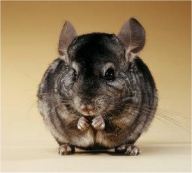Chinchillas as Pets
Domestic chinchillas can be kept as pets, but they are naturally skittish and are not considered to be good pets for small children as they have delicate bones and generally do not like to be held. Chinchillas live, on average, 15 years, but some have been known to live up to 20 or more.
Chinchillas make many noises, including barks, chirps, and squeaks. They have a different noise for every situation, from a calm, loving chirp given to a potential mate to a loud, aggressive bark when spooked. They can be housed with other chinchillas of the same sex as long as they don't fight. |
 |
They need a large cage with many wood shelves to leap on. Toys can be added including hanging wooden toys, a large wheel (not made of mesh so their legs and toes don't get caught), or paper towel tubes. Wooden sticks and chew toys are also good options.
Plastic in the cage should be avoided at all times. Chinchillas are often voracious chewers and any ingested plastic can cause blockage in the intestines. As with most small animals, red cedar bedding should never be used due to its toxic nature.
The cage must have good air circulation. The chinchilla can not sweat, therefore, if temperatures go above 25°C (75°F), the chinchilla could get overheated and may suffer from heat stroke.
Chinchillas can be found in a variety of colors including the standard grey, beige, ebony, and many others. They instinctively clean their fur by taking dust baths several times a week, in which they roll around in a container full of special chinchilla dust made of sand or fine pumice. Chinchillas have no guard hairs so it is important a chinchilla never get wet because their fur retains the moisture and can grow fungus if not dried quickly with a blow dryer on a low, cool setting.
|